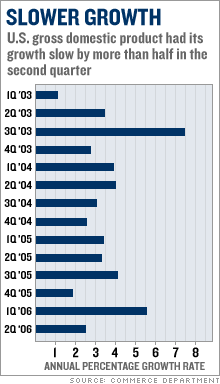|
GDP hits the brakes Broad measure of nation's economic growth comes in below forecasts, hopes for a Fed rate hike pause rise. NEW YORK (CNNMoney.com) -- The nation's economic growth slowed significantly in the second quarter, according to a government report Friday that came in well below Wall Street expectations, raising expectations that the Federal Reserve won't raise interest rates again at its next meeting. The gross domestic product, the broad measure of the nation's economic activity, grew at a 2.5 percent annual rate in the three months ended in June, according to the Commerce Department's initial reading for the period. That's down from the 5.6 percent growth rate in the first quarter.
Economists surveyed by Briefing.com had forecast growth of 3 percent in the most recent quarter. The report raised hopes among some investors and economists that the Fed might not be as likely to raise interest rates for the 18th straight time at its next meeting Aug. 8. Chairman Ben Bernanke told Congress earlier this month that a cooling of the economy could act to keep prices in check, lessening the need for further rate hikes. "I think today's report makes a pause (in rate hikes) more likely," said Zoltan Pozsar economist with Moody's Economy.com, who said he now thinks there's between a 30 and 40 percent chance of a hike in August, where as it was slightly better than a 50 percent before Friday's reports. "The economy is not on fire," he said. The Chicago Board of Trade's fed funds futures were pricing in only a 30 percent chance of a rate hike in August during midday trading Friday, compared to a 46 percent chance at Thursday's close. The yield on the 10-year treasury fell to 4.99 percent in mid-morning trading, from 5.04 percent just before the report. Still there are concerns about inflation that could keep the Fed raising rates to keep prices in check. The GDP report included some closely watched inflation measures. The overall price deflator rose at a 3.3 percent annual rate, up from the 3.1 percent reading in the first quarter, but below forecasts of a 3.4 percent rise. The so called core PCE reading, which measures prices paid by individuals for items excluding food and energy was up at a 2.9 percent annual rate, up from a 2.1 percent rise in the first quarter, but in line with forecasts. Economist Bob Brusca of FAO Economics said that he believes inflationary pressures in the report are high enough to keep the Fed hiking rates. He said that weak business spending on capital investment is greatly responsible for the weaker than expected results, and that with corporate earnings staying strong, that is likely to bounce back. "What you have right now is a technical slow down. It's a strong first quarter followed by weaker second quarter," said Brusca. "The core PCE is nearly 50 percent over the top of their inflation limit. It's clear Bernanke would like to pause, but I don't see how they can and still keep their credibility." In a separate report with inflation implications, the Labor Department's Employment Cost Index rose 0.9 percent, up from a 0.6 percent gain in the first quarter, and slightly higher than the 0.8 percent forecast of economists. Some economists say the report Tuesday on personal income and spending, which contains a more closely watched PCE reading, as well as the Aug. 4 employment report, will be more important to the Fed think than the numbers in the GDP report. |
|


